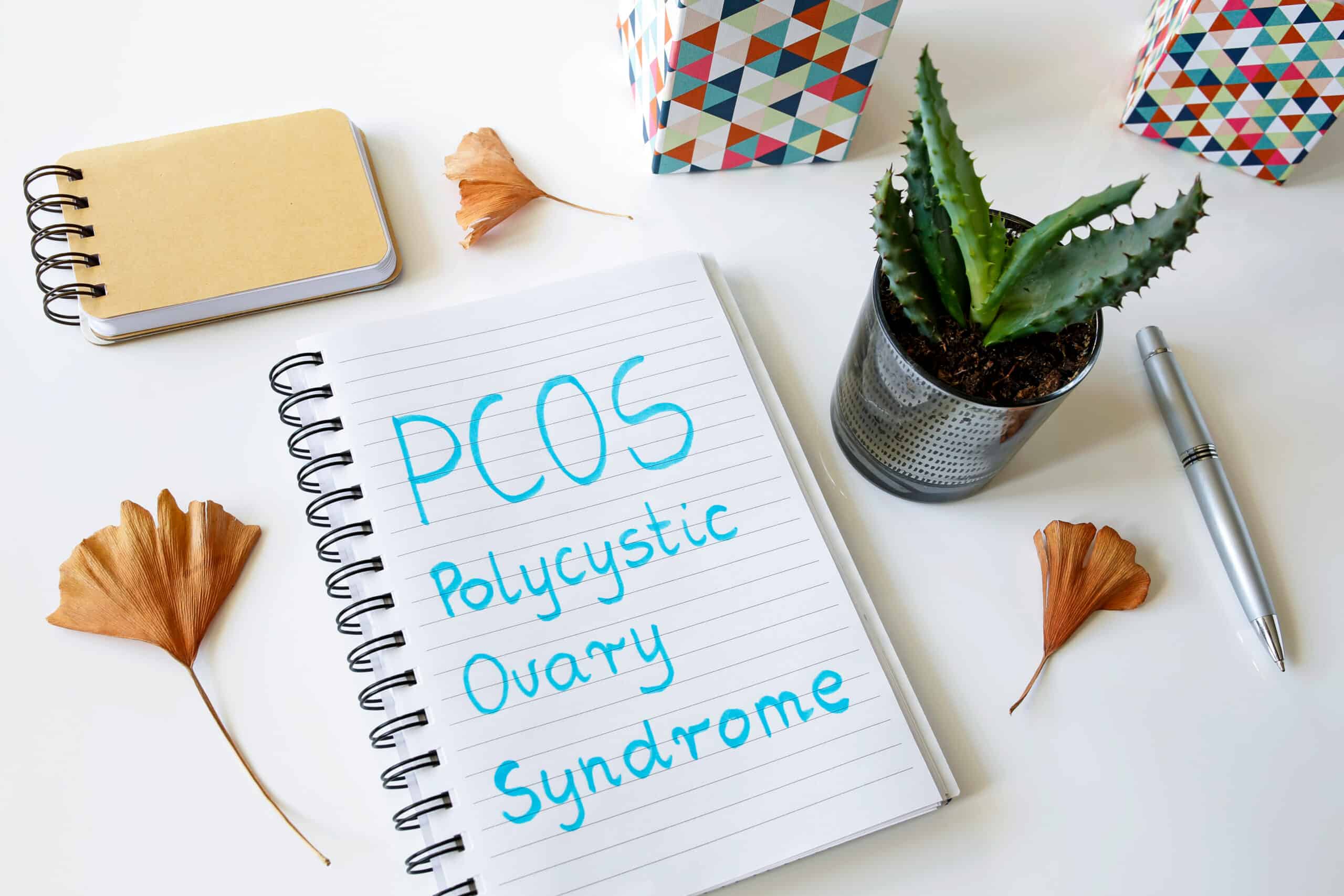The aim of PCOS Awareness Month is to help improve the lives of those affected by PCOS and to help them to overcome their symptoms as well as prevent and reduce their risks for life-threatening related conditions.
What is PCOS?
 PCOS is the most common hormonal disorder in women, affecting up to 20% of all reproductive-aged women. There is unexplained abnormal synchrony from the brain to the ovaries resulting in an elevation in the male hormone (testosterone) and lack of ovulation. The diagnosis is based on having two of the following three criteria: ovulation dysfunction/abnormal menstrual intervals; unwanted hair growth in a male pattern or elevated in blood testosterone levels; and ultrasound appearance of polycystic ovaries. As little as 5-10% weight loss can help regulate menstrual intervals. Insulin resistance/Pre-diabetes is present in up to 40% of these women and diabetes can be seen in 10%. The naturally occurring substance inositol has been shown to decrease insulin resistance.
PCOS is the most common hormonal disorder in women, affecting up to 20% of all reproductive-aged women. There is unexplained abnormal synchrony from the brain to the ovaries resulting in an elevation in the male hormone (testosterone) and lack of ovulation. The diagnosis is based on having two of the following three criteria: ovulation dysfunction/abnormal menstrual intervals; unwanted hair growth in a male pattern or elevated in blood testosterone levels; and ultrasound appearance of polycystic ovaries. As little as 5-10% weight loss can help regulate menstrual intervals. Insulin resistance/Pre-diabetes is present in up to 40% of these women and diabetes can be seen in 10%. The naturally occurring substance inositol has been shown to decrease insulin resistance.
How common is PCOS?
affecting up to 1 in 5 reproductive-aged women and is the most common cause of infertility
What are the best treatments for PCOS?
The treatment is based on the interest of the patient, i.e. pregnancy or control of abnormal uterine bleeding. There are two categories of risks:
Reproductive
Medical
Any abnormality in the medical column above needs to be addressed prior to any consideration of pregnancy. For pregnancy, we recommend an optimal body weight. Ovulation induction can occur with oral medication, most effective is letrozole, particularly in overweight women; other options are surgery on the ovaries (ovarian drilling) and in-vitro fertilization (IVF).
What are some of the lesser-known or subtler signs of PCOS?
- Acanthosis nigricans – darkening of the skin in the folds (upper inner thigh, under breasts, between fingers)
- Pre-diabetes – up to 40% of PCOS women, particularly overweight, will have this condition; up to 10% will have diabetes due to the association with the metabolic syndrome (http://www.SciRP.org/journal/ojog/)
- Endometrial hyperplasia – this is pre-uterine cancer resulting from the lack of ovulation causing continuous estrogen stimulation to the uterine lining without protection from progesterone (the hormone from ovulation)
- Elevated blood pressure – due to the association with the Metabolic Syndrome** (found in up to 50% of PCOS women)
- Elevated Cholesterol & Triglycerides – due to the association with the Metabolic Syndrome
- Early male pattern hair growth pre-pubertal – due to elevated male hormone
- Bodyweight – up to 35% of PCOS women have a normal BMI (body mass index); weight gain can result in irregular periods, uncovering a previously undiagnosed PCOS patient
- Acne – in addition to male pattern hair growth
- Scalp hair loss – also due to elevated testosterone
- Be sure to exclude more serious causes that may present like PCOS (male hormone producing tumor, Cushing’s syndrome, enzyme deficiency)
- Increased risk for cardiovascular disease
- PCOS and the metabolic syndrome will remain even if the women’s ovaries are removed
- Infertility due to a lack of ovulation
- Abnormal uterine bleeding – PCOS women have markedly abnormal period intervals ranging from daily to absent
**The National Cholesterol Education Pro-gram Adult Treatment Panel (NCEPATP) defined the metabolic syndrome as the presence of three of the five following factors: waist circumference greater than 88 cm in females; fasting serum glucose 110 mg/dl or more; fasting serum triglycerides greater than 150 mg/dl; serum HDL-cholesterol less than 50 mg/dl; and blood pressure greater than 130/85 mm Hg
It is extremely important to see your Gynecologist due to the risks of not ovulating i.e., precancer and possible cancer of the uterus, abnormal uterine bleeding, infertility, and the metabolic syndrome
Are there treatments for PCOS?
While there is no cure for PCOS, management is based on reducing the Gynecologic and Metabolic risks. So, behavioral modification for weight loss including aggressive lifestyle management may avoid diabetic and cardiovascular complications. Further, weight loss may help restore regular menstrual intervals and ovulation. Metformin has been shown to improve the live birth rate in ovulation induction when combined with clomiphene citrate. The birth control pill can help reduce unwanted male pattern hair as well as maintain regular menstrual bleeding for uterine protection of cancer.
Since elevated body weight worsens PCOS, appropriate weight loss is the first approach to potentially restore ovulation and reduce the medical complications of PCOS. For PCOS women trying to conceive, we prescribe ovulation induction with oral medication. The success of this approach will vary based on a woman’s age and body weight. If she is unable to ovulate with medication or unsuccessful in pregnancy, the options are laparoscopy with ovarian drilling (LOD) or In-vitro fertilization (IVF).
LOD is a well-established outpatient procedure used to assist women with PCOS, first reported in 1984. A viewing device called a laparoscope is placed through the women’s umbilicus (belly button) to view her pelvic organs; other small puncture sites for additional instruments are usually necessary. While the exact mechanism is not understood, the procedure involves multiple punctures into the ovary using electrocautery resulting in a reduction in the male hormone producing (theca) cells. Pregnancy success rates are typically 50-80%.
LOD restoring ovulation with regular menses has significant benefits including treating infertility, protecting the uterine lining from cancer, reducing testosterone to improve acne and unwanted hair growth, and avoiding anemia from continued bleeding.
So, the best candidates for LOD are PCOS women who have been unsuccessful on medication to ovulate as well as women who have persistent abnormal bleeding despite hormonal treatment. There is no indication for LOD other than in women with PCOS.
Are there treatments for PCOS?
While there is no cure for PCOS, management is based on reducing the Gynecologic and Metabolic risks. So, behavioral modification for weight loss including aggressive lifestyle management may avoid diabetic and cardiovascular complications. Further, weight loss may help restore regular menstrual intervals and ovulation. Metformin has been shown to improve the live birth rate in ovulation induction when combined with clomiphene citrate. The birth control pill can help reduce unwanted male pattern hair as well as maintain regular menstrual bleeding for uterine protection of cancer.
Since elevated body weight worsens PCOS, appropriate weight loss is the first approach to potentially restore ovulation and reduce the medical complications of PCOS. For PCOS women trying to conceive, we prescribe ovulation induction with oral medication. The success of this approach will vary based on a woman’s age and body weight. If she is unable to ovulate with medication or unsuccessful in pregnancy, the options are laparoscopy with ovarian drilling (LOD) or In-vitro fertilization (IVF).
LOD is a well-established outpatient procedure used to assist women with PCOS, first reported in 1984. A viewing device called a laparoscope is placed through the women’s umbilicus (belly button) to view her pelvic organs; other small puncture sites for additional instruments are usually necessary. While the exact mechanism is not understood, the procedure involves multiple punctures into the ovary using electrocautery resulting in a reduction in the male hormone producing (theca) cells. Pregnancy success rates are typically 50-80%.
LOD restoring ovulation with regular menses has significant benefits including treating infertility, protecting the uterine lining from cancer, reducing testosterone to improve acne and unwanted hair growth, and avoiding anemia from continued bleeding.
So, the best candidates for LOD are PCOS women who have been unsuccessful on medication to ovulate as well as women who have persistent abnormal bleeding despite hormonal treatment. There is no indication for LOD other than in women with PCOS.






